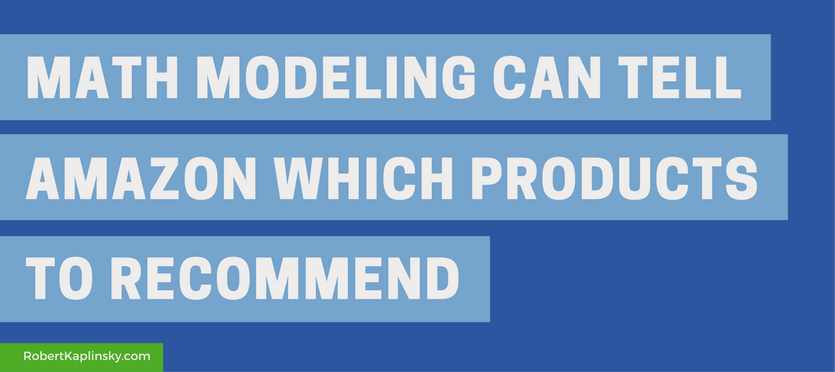[This is one of a series of posts that explore real world examples of mathematical modeling to help educators better understand its applications. This is not intended to be a context for a student lesson. To learn about Spies and Analysts, I recommend watching this webinar (with elementary, middle, and high school versions) or reading this blog post.]
What if I told you that you could make billions of dollars by using mathematical modeling? Well, that’s exactly what Amazon has been using when they recommend products for you to buy. These product recommendations frequently come in the form of “People who bought __________ often buy __________, __________, or __________” and result in additional purchases that generate significant revenue.
So, what if you worked for Amazon and they tasked you with creating a formula to make these recommendations? Where would you begin? What information would you want to know? What would you do with that data once you had access to it? These are the topics I’m exploring in my spies and analysts post. I want to walk you through the process so that you can better appreciate the complexities of mathematical modeling.
The first part of the process requires the spies. So, I want you to stop and take thirty seconds to think about what information you would use to make your product recommendations. What would you consider? Where the customer lives? The time of day? Upcoming holidays? The customer’s gender? The list could go on and on. Once you’ve determined what information you’d want, keep reading.
- Previously purchased items may suggest interests
- Items added to carts but not purchased
- Pricing experiments online where they offer the same products at different prices and see the results
- Experiments where they offer products in different “bundles”
- Your wishlists
- Other sites you’ve visited may provide information about your interests
- How long you look at an item before moving on
- Product ratings you or people in your social network have left
- Demographic information such as your shipping address to know what people in your general area like
- Clicking on a link in an email
- Items you viewed on their site
- Number of times you viewed an item before final purchase
- Purchase history from other partner stores
If you’re not feeling overwhelmed by the sheer magnitude of that level of data, you should be. It’s a blessing and a curse because while the information is very helpful Amazon likely has more information in those categories than we can possibly imagine. Now what do you even do with it all? Should each piece of information be equally important? If not, how would you combine and weigh each one? This is where the analysts come in. Their job is to take the data and break it down in such a way that it becomes useful. Take 30 more seconds to think about which of those factors you would prioritize.
At this point, there are no computers or calculators that can figure this out on their own. This is where the jobs are at. If we truly want to focus our time and energy in a skill that will really help our students become college and career ready, mathematical modeling is where we need to be.


Do you have problem sets where students can try this out? Or where could you get different set of data where students come up with their own algorithms and justify their ideas?
Hi Kay. I don’t have anything of this scale or anything that would really come close to trying to synthesize this type of data set. Perhaps students could figure out what data they’d want and then survey classmates to create it? Wouldn’t be ideal but seems doable.
It’s too bad that future high paying jobs are ones that exploit people to make a billionaire richer.